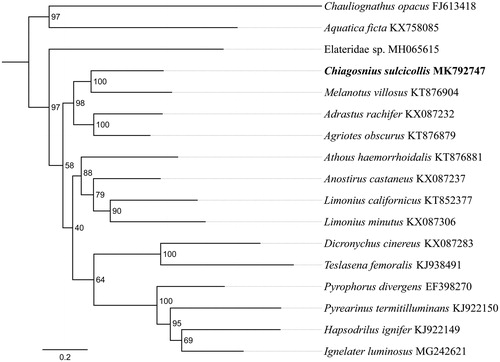Abstract
In this study, we determined the complete mitochondrial genome sequence of click beetle Chiagosnius sulcicollis (Candeze, 1878) (GenBank accession no. MK792747) using next-generation sequencing (NGS) method. The mitogenome is 15,848 bp in length, consisting of 13 protein-coding genes (PCGs), 2 ribosomal RNA genes, 22 transfer RNA genes, and 1 non-coding control region. The overall nucleotide composition was 41.6% A, 31.5% T, 16.6% C, and 10.3% G, with 73.1% AT, respectively. The gene arrangement is consistent with the typical insect mitochondrial genome. Phylogenetic analysis revealed that C. sulcicollis clustered into a clade with Melanotus villosus with high bootstrap support.
Elateridae commonly known as click beetles due to a unique and well-known startling defence mechanism named ‘clicking’ contains approximately 10,000 species (Johnson Citation2002). Chiagosnius sulcicollis, with yellowish-brown vertical stripe in the middle of the fore wing, mainly distributed in southern China and Southeast Asia (Jiang and Wang Citation1999). Here, we determined the complete mitochondrial genome of C. sulcicollis, which is the first mitochondrial genome sequenced to date in the genus of Chiagosnius.
The sampled specimen was collected from Jianfengling National Nature Reserve, Hainan, China (18°44′ N, 108°54′ E) in May, 2018. The specimen was stored in the Entomological specimen room of Shangluo University. The complete mitochondrial DNA sequence was determined by Illumina HiSeq 2500 Sequencing System (Illumina, San Diego, CA). In total, 5.2 Gb raw reads were obtained, quality-trimmed, and assembled using MITObim v1.7 (Hahn et al. Citation2013).
The complete mitochondrial genome of C. sulcicollis was 15,848 bp in total length and deposited in GenBank database with an accession number MK792747. The overall base composition was 41.6% A, 31.5% T, 16.6% C, and 10.3% G, with an A + T ratio of 73.1%. The full mitochondrial genome contains 13 protein-coding genes (PCGs), 22 transfer RNAs (tRNAs), two ribosomal RNAs (rRNAs) and a putative control region (CR). The gene arrangement of C. sulcicollis is found to be similar to most insect mitochondrial genomes (Wolstenholme Citation1992). Most PCGs of C. sulcicollis have the conventional start codon for invertebrate mitochondrial PCGs (ATN), with the exception of nad1 (TTG) and cox1 (AAT), as the asparagine (AAT or AAC) are proposed to be the start codon for cox1 in suborder Polyphaga (Sheffield et al. Citation2008). Most of the PCGs terminate with the stop codon TAA or TAG, whereas cox2, cox3 and nad5 end with the incomplete codon T. Nine protein-coding genes are encoded on the majority strand (J-strand) and four (nad5, nad4, nad4L, and nad1) on the minority strand (N-strand). All 22 tRNA genes can be folded into the typical cloverleaf structure except for trnS1, in which the dihydrouridine (DHU) arm cannot form a stable stem-loop structure but a simple loop. Two rRNA genes (rrnL and rrnS) locate at trnL1/trnV and trnV/control regions, respectively, and both rRNA genes are encoded on the N-strand. The lengths of the two rRNA genes (rrnL and rrnS) in C. sulcicollis are about 1283 and 738 bp, with the A + T contents of 78.1 and 75.9%, respectively. The length of the control region is 1235 bp, with the AT content of this region being ∼81.3%.
The phylogenetic tree was constructed using the maximum-likelihood method through raxmlGUI 1.5 (Silvestro and Michalak Citation2012). Results showed that the family Elateridae is monophyletic and C. sulcicollis is sister to Melanotus villosus (), which was consistent with the previous studies (Douglas Citation2011; Lin et al. Citation2018; Meng et al. Citation2018). In conclusion, we obtained and described the complete mitochondrial genome of C. sulcicollis, which constitute a valuable and useful resource for population genetic study and identification efforts on this species.
Disclosure statement
All authors have read and approved the final manuscript. No conflict of interest was reported by the authors.
Additional information
Funding
References
- Douglas H. 2011. Phylogenetic relationships of Elateridae inferred from adult morphology, with special reference to the position of Cardiophorinae. Zootaxa. 2900:1–45.
- Hahn C, Bachmann L, Chevreux B. 2013. Reconstructing mitochondrial genomes directly from genomic next-generation sequencing reads-a baiting and iterative mapping approach. Nucl Acids Res. 41:e129.
- Jiang SH, Wang SY. 1999. Economic click beetle faun-na of China (Coleoptera: Elateridae). Beijing (China): China Agriculture Press.
- Johnson PJ. 2002. Elateridae. In: Arnett RH, Thomas MC, Skelley PE, Frank JH, editors. American beetles. Vol. 2. Boca Raton (FL): CRC Press LLC; p. 160–173.
- Lin A, Zhao X, Song N, Zhao T. 2018. Analysis of the complete mitochondrial genome of click beetle Agriotes hirayamai (Coleoptera: Elateridae). Mitochondrial DNA Part B. 3:290–291.
- Meng ZY, Lei CL, Chen XQ, Shi TX, Chen QJ, Jiang SH. 2018. Phylogenetic analysis of click beetles (Coleoptera: Elateridae) based upon 28S rDNA: phylogeny and classification. Entomotaxonomia. 40:231–252.
- Sheffield N, Song H, Cameron S, Whiting M. 2008. A comparative analysis of mitochondrial genomes in Coleoptera (Arthropoda: Insecta) and genome descriptions of six new beetles. Mol Biol Evol. 25:2499–2509.
- Silvestro D, Michalak I. 2012. RaxmlGUI: a graphical front-end for RAxML. Org Divers Evol. 12:335–337.
- Wolstenholme DR. 1992. Animal mitochondrial DNA: structure and evolution. Int Rev Cytol. 141:173–216.

